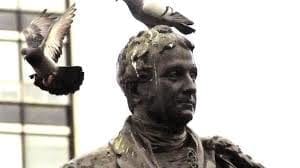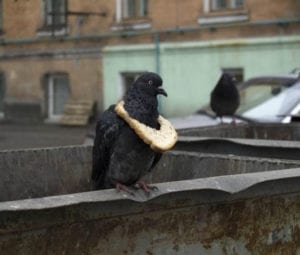
by Pigeon Patrol | Apr 29, 2020 | 4-S Gel Bird repellent, Animal Deterrent Products, Bird Deterrent Products, Bird Netting, Bird Spike, Bird Spikes, Pigeon Control, Pigeon Droppings, Pigeon Patrol's Services, Pigeon Spikes, Pigeons in the News, UltraSonic Bird Control
Bangkok bans feeding wild pigeons. Prime Minister Gen Prayut Chan-o-cha has ordered the Bangkok Metropolitan Administration and other agencies to bans the feeding of wild pigeons, government spokesman Lt Gen Sansern Kaewkamnerd said on Wednesday.
Sansern said the ban is a measure to control wild pigeon numbers and prevent disease.
He said residents filed complaints about that the growing number of the wild birds causing a nuisance.
“The prime minister instructed all agencies to find measures to clean the areas but the birds must not be harmed,” Sansern said.
“But the people will not be allowed to feed the birds to reduce their number at each spot. The provincial administrations may set aside areas for feeding the birds.”
Sansern cited the pier of Wat Rakang Kositaram in Bangkok as an example of feeding of wild pigeons that caused trouble to passers-by.
He said bird lovers ignored signs and fed the birds, which caused disturbances.
Source
About Pigeon Patrol:
Pigeon Patrol Products & Services is the leading manufacturer and distributor of bird deterrent (control) products in Canada. Pigeon Patrol products have solved pest bird problems in industrial, commercial, and residential settings since 2000, by using safe and humane bird deterrents with only bird and animal friendly solutions. At Pigeon Patrol, we manufacture and offer a variety of bird deterrents, ranging from Ultra-flex Bird Spikes with UV protection, Bird Netting, 4-S Gel and the best Ultrasonic and audible sound devices on the market today.
Contact us at 1- 877– 4– NO-BIRD, (604) 585-9279 or visit our website at www.pigeonpatrol.ca
Bird Gone, Pigeon Gone, Seagull Gone, Pigeon problems, pigeon spikes, 1-877-4NO-BIRD, 4-S Gel, Bird Control, Pigeon Control, bird repellent, Bird Spikes, sonic bird repellent, stainless steel bird spikes, bird spikes Vancouver, Ultra Sonic Bird Control, Bird Netting, Plastic Bird Spikes, Canada bird spike deterrents, Pigeon Pests, B Gone Pigeon, Pigeon Patrol, pest controller, pest control operator, pest control technician, Pigeon Control Products, humane pigeon spikes, pigeon deterrents, pigeon traps, Pigeon repellents, Sound & Laser Deterrents, wildlife control, raccoon, skunk, squirrel deterrent, De-Fence Spikes, Dragons Den, Canada bird spikes, Canada pigeon, pigeon control, pidgon patrol, pidgon. Kill pigeons, crow, starling

by Pigeon Patrol | Apr 29, 2020 | 4-S Gel Bird repellent, Animal Deterrent Products, Bird Deterrent Products, Bird Netting, Bird Spike, Bird Spikes, Pigeon Control, Pigeon Droppings, Pigeon Patrol's Services, Pigeon Spikes, Pigeons in the News, UltraSonic Bird Control
Rumor claims the Islamic State (ISIS) banned pigeons because the visibility of their genitals as they fly overhead “offends Islam.”
Claim: ISIS has banned pigeons because their visible genitals in flight “offends Islam.”
I’m seeing reports that ISIS clerics have banned pigeon breeding because the sight of pigeon genitals is offensive to Muslim sensibilities. Since pigeon genitalia is something I’ve never in my 60+ yrs seen I doubt the truth of this story.
Origins: On 2 June 2015, the British Daily Mail newspaper published an article titled “ISIS bans pigeon breeding — punishable by public flogging — because seeing birds’ genitals overhead offends Islam.” In short order, the newspaper’s claim was widely aggregated to other outlets, with its multiple iterations lending it an air of credibility:
When rumours of an ISIS ban on pigeons began to circulate earlier this year, it was widely assumed that it was related to the birds being used to either smuggle anti-ISIS messages or cigarettes.
However the new document clears up that misunderstanding, clearly stating that the ban is intended ‘to put a stop to the greater criminal act of harming one’s Muslim and Muslim women neighbours, revealing the [pigeon’s] genitals and wasting time.’
On 5 June 2015, the claim received additional attention when HBO host Bill Maher discussed it at length during a segment of his show Real Time with Bill Maher. Maher pointed to ISIS’s purported pigeon genitalia ban as an example of how Islam’s core ideology was incongruent with that of the Western world
Full story here
About Pigeon Patrol:
Pigeon Patrol Products & Services is the leading manufacturer and distributor of bird deterrent (control) products in Canada. Pigeon Patrol products have solved pest bird problems in industrial, commercial, and residential settings since 2000, by using safe and humane bird deterrents with only bird and animal friendly solutions. At Pigeon Patrol, we manufacture and offer a variety of bird deterrents, ranging from Ultra-flex Bird Spikes with UV protection, Bird Netting, 4-S Gel and the best Ultrasonic and audible sound devices on the market today.
Contact us at 1- 877– 4– NO-BIRD, (604) 585-9279 or visit our website at www.pigeonpatrol.ca
Bird Gone, Pigeon Gone, Seagull Gone, Pigeon problems, pigeon spikes, 1-877-4NO-BIRD, 4-S Gel, Bird Control, Pigeon Control, bird repellent, Bird Spikes, sonic bird repellent, stainless steel bird spikes, bird spikes Vancouver, Ultra Sonic Bird Control, Bird Netting, Plastic Bird Spikes, Canada bird spike deterrents, Pigeon Pests, B Gone Pigeon, Pigeon Patrol, pest controller, pest control operator, pest control technician, Pigeon Control Products, humane pigeon spikes, pigeon deterrents, pigeon traps, Pigeon repellents, Sound & Laser Deterrents, wildlife control, raccoon, skunk, squirrel deterrent, De-Fence Spikes, Dragons Den, Canada bird spikes, Canada pigeon, pigeon control, pidgon patrol, pidgon. Kill pigeons, crow, starling
by Pigeon Patrol | Apr 29, 2020 | 4-S Gel Bird repellent, Animal Deterrent Products, Bird Deterrent Products, Bird Netting, Bird Spike, Bird Spikes, Pigeon Control, Pigeon Droppings, Pigeon Patrol's Services, Pigeon Spikes, Pigeons in the News, UltraSonic Bird Control
The fate of Abbotsford’s urban pigeon prohibition is still unclear after council received a report last week that noted the bird ban aligns with the city’s current zoning bylaw, but that those regulations are currently under review.
The issue was raised last fall by Gurbir Brar, who raises pigeons and says the bylaw banning them is irrational and unnecessary.
Brar told council in October that other jurisdictions, including Calgary and Surrey, allow the keeping of hobby pigeons in residential areas, without a problem. He compared pigeons to cats, and said the birds – when properly trained – are much less disruptive than felines to the surrounding community. He was accompanied by more than a dozen fellow pigeon fanciers.
Staff were directed to prepare a report, which was presented to council last week.
In it, assistant planner Nick Crosman notes that pigeons are currently defined as poultry, rather than pets, and thereby are an agriculture use. Currently, residential zones don’t permit such uses.
But the city’s zoning bylaw is currently undergoing a revision to align it with the 2016 Official Community Plan. That document would seem to be more friendlier to pigeon-rearing, and includes a statement that suggests council consider allowing “urban agriculture activities that encourage self-sufficiency.” Pigeons and backyard fowl aren’t mentioned in the OCP.
The updated zoning bylaw will come to council for approval or revision. Any changes would require a public hearing. The fate of pigeon ban to be decided
Source
About Pigeon Patrol:
Pigeon Patrol Products & Services is the leading manufacturer and distributor of bird deterrent (control) products in Canada. Pigeon Patrol products have solved pest bird problems in industrial, commercial, and residential settings since 2000, by using safe and humane bird deterrents with only bird and animal friendly solutions. At Pigeon Patrol, we manufacture and offer a variety of bird deterrents, ranging from Ultra-flex Bird Spikes with UV protection, Bird Netting, 4-S Gel and the best Ultrasonic and audible sound devices on the market today.
Contact us at 1- 877– 4– NO-BIRD, (604) 585-9279 or visit our website at www.pigeonpatrol.ca
Bird Gone, Pigeon Gone, Seagull Gone, Pigeon problems, pigeon spikes, 1-877-4NO-BIRD, 4-S Gel, Bird Control, Pigeon Control, bird repellent, Bird Spikes, sonic bird repellent, stainless steel bird spikes, bird spikes Vancouver, Ultra Sonic Bird Control, Bird Netting, Plastic Bird Spikes, Canada bird spike deterrents, Pigeon Pests, B Gone Pigeon, Pigeon Patrol, pest controller, pest control operator, pest control technician, Pigeon Control Products, humane pigeon spikes, pigeon deterrents, pigeon traps, Pigeon repellents, Sound & Laser Deterrents, wildlife control, raccoon, skunk, squirrel deterrent, De-Fence Spikes, Dragons Den, Canada bird spikes, Canada pigeon, pigeon control, pidgon patrol, pidgon. Kill pigeons, crow, starling

by Pigeon Patrol | Apr 22, 2020 | 4-S Gel Bird repellent, Animal Deterrent Products, Bird Deterrent Products, Bird Netting, Bird Spike, Bird Spikes, Pigeon Control, Pigeon Droppings, Pigeon Patrol's Services, Pigeon Spikes, Pigeons in the News, UltraSonic Bird Control
Pigeon build-up cited in bridge collapse. St. PAUL, Minn.–Pounded and strained by heavy traffic and weakened by missing bolts and cracking steel, the failed interstate bridge over the Mississippi River also faced a less obvious enemy: Birds, specifically pigeons.
Inspectors began documenting the build-up of pigeon dung on the span near downtown Minneapolis two decades ago.
Experts say the corrosive guano deposited all over the bridge’s framework helped the steel beams rust faster.
Although investigators have yet to identify the cause of the bridge’s Aug. 1 collapse, which killed at least 13 people and injured about 100, the pigeon problem is one of many factors that dogged the structure.
“There is a coating of pigeon dung on steel with nest and heavy build-up on the inside hollow box sections,” inspectors wrote in a 1987-1989 report.
In 1996, screens were installed over openings in the bridge’s beams to keep pigeons from nesting there, but that didn’t prevent the build-up of droppings elsewhere.
Pigeon droppings contain ammonia and acids, said chemist Neal Langerman, of the American Chemical Society. If the dung isn’t washed away, it dries out and turns into a concentrated salt. When water gets in and combines with the salt and ammonia, it creates small electrochemical reactions that rust the steel underneath.
“Every time you get a little bit of moisture there, you wind up having a little bit of electrochemistry occurring and you wind up with corrosion,” said Langerman. “Over a long term, it might in fact cause structural weaknesses.”
Source
About Pigeon Patrol:
Pigeon Patrol Products & Services is the leading manufacturer and distributor of bird deterrent (control) products in Canada. Pigeon Patrol products have solved pest bird problems in industrial, commercial, and residential settings since 2000, by using safe and humane bird deterrents with only bird and animal friendly solutions. At Pigeon Patrol, we manufacture and offer a variety of bird deterrents, ranging from Ultra-flex Bird Spikes with UV protection, Bird Netting, 4-S Gel and the best Ultrasonic and audible sound devices on the market today.
Contact us at 1- 877– 4– NO-BIRD, (604) 585-9279 or visit our website at www.pigeonpatrol.ca
Bird Gone, Pigeon Gone, Seagull Gone, Pigeon problems, pigeon spikes, 1-877-4NO-BIRD, 4-S Gel, Bird Control, Pigeon Control, bird repellent, Bird Spikes, sonic bird repellent, stainless steel bird spikes, bird spikes Vancouver, Ultra Sonic Bird Control, Bird Netting, Plastic Bird Spikes, Canada bird spike deterrents, Pigeon Pests, B Gone Pigeon, Pigeon Patrol, pest controller, pest control operator, pest control technician, Pigeon Control Products, humane pigeon spikes, pigeon deterrents, pigeon traps, Pigeon repellents, Sound & Laser Deterrents, wildlife control, raccoon, skunk, squirrel deterrent, De-Fence Spikes, Dragons Den, Canada bird spikes, Canada pigeon, pigeon control, pidgon patrol, pidgon. Kill pigeons, crow, starling

by Pigeon Patrol | Apr 22, 2020 | 4-S Gel Bird repellent, Animal Deterrent Products, Bird Deterrent Products, Bird Netting, Bird Spike, Bird Spikes, Pigeon Control, Pigeon Droppings, Pigeon Patrol's Services, Pigeon Spikes, Pigeons in the News, UltraSonic Bird Control
Conwy Road Bridge repair bill rises as pigeon poo hides rust.

Pigeon with a bread necklace. A new symbol of wealth among pigeon flocks.
Bridge repair costs have more than doubled because pigeon poo disguised rust.
Council officials struck a deal for the work on Conwy Road Bridge in 2016.
Costs shot up by £844,000 to £1.53m after an inspection revealed rust on the structure was hidden by the birds’ droppings.
Conwy council chief executive Iwan Davies said it was not possible to identify the extent of the works but a councillor said it was “disappointing”.
Repairs for the two lane bridge, which takes traffic across the town’s estuary, were sent out to tender in 2016.
A report by the council’s audit committee said the “considerable” extra work needed had not been found originally because of “access” problems.
“The additional works…significantly impacted the total cost of the works,” the report said.
Gele ward councillor Andrew Wood said: “I can’t believe we’ve not made more of an issue about this refurbishment, it’s plus £844,000.
“If the council tendered with all that information in the first place then it would have cost less. But we’re in a situation now where we have to carry on, so I’m disappointed.”
Mr Davies added: “It wasn’t an overspend as such, it was a re-calibration of what needed to be done.”
Source
About Pigeon Patrol:
Pigeon Patrol Products & Services is the leading manufacturer and distributor of bird deterrent (control) products in Canada. Pigeon Patrol products have solved pest bird problems in industrial, commercial, and residential settings since 2000, by using safe and humane bird deterrents with only bird and animal friendly solutions. At Pigeon Patrol, we manufacture and offer a variety of bird deterrents, ranging from Ultra-flex Bird Spikes with UV protection, Bird Netting, 4-S Gel and the best Ultrasonic and audible sound devices on the market today.
Contact us at 1- 877– 4– NO-BIRD, (604) 585-9279 or visit our website at www.pigeonpatrol.ca
Bird Gone, Pigeon Gone, Seagull Gone, Pigeon problems, pigeon spikes, 1-877-4NO-BIRD, 4-S Gel, Bird Control, Pigeon Control, bird repellent, Bird Spikes, sonic bird repellent, stainless steel bird spikes, bird spikes Vancouver, Ultra Sonic Bird Control, Bird Netting, Plastic Bird Spikes, Canada bird spike deterrents, Pigeon Pests, B Gone Pigeon, Pigeon Patrol, pest controller, pest control operator, pest control technician, Pigeon Control Products, humane pigeon spikes, pigeon deterrents, pigeon traps, Pigeon repellents, Sound & Laser Deterrents, wildlife control, raccoon, skunk, squirrel deterrent, De-Fence Spikes, Dragons Den, Canada bird spikes, Canada pigeon, pigeon control, pidgon patrol, pidgon. Kill pigeons, crow, starling





